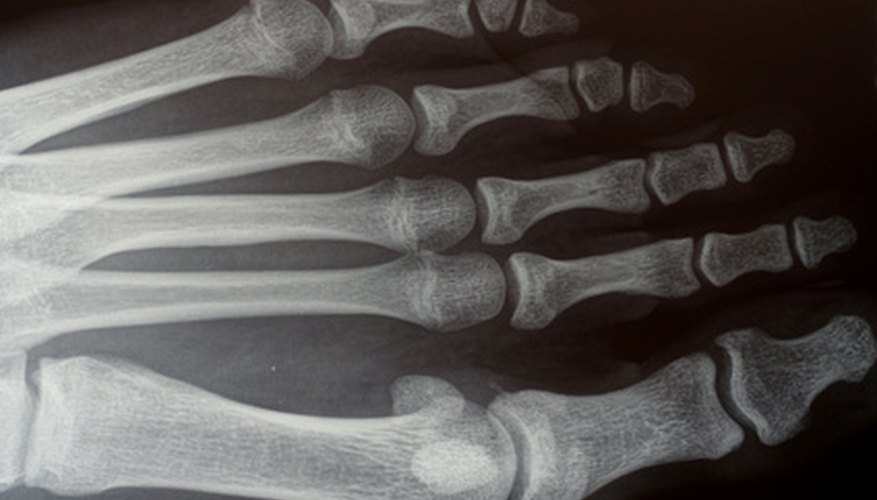A bone density test, also called a DXA scan, can help determine whether a person is at risk for osteoporosis, a disease which causes the bones to become weaker and more easily broken. It uses X-rays to determine how many minerals, such as calcium, there are in a section of bone. Dark spots can indicate where the bone is less dense and contains less calcium.
Bone Density Test
A bone density test works like an X-ray, taking pictures of the bones, typically the spine and hip. Smaller machines may measure the density of the bones in the wrists, ankles or feet, however a central scan which looks at the spine and hip is usually the most accurate at detecting low bone density. The scan is painless and exposes a person to a minuscule amount of radiation, about 1/10th of what a regular X-ray would cause.
Dark Spots
Dark spots on a bone density test may indicate places where the bone is less dense. This can be caused by osteoporosis or other factors. Some types of bone cancer, called osteolytic cancers, can also cause dark spots to show up on a bone scan, because they also reduce the density of the bone.
Results
Usually, the doctor will give the results of a bone density test as two numbers, a T-score and a Z-score. The T-score rates the patient's bone density as compared to the bone density of a healthy 30-year-old. A T-score between 1 and -1 is considered normal, but a T-score that is between -1 and -2.5 indicates low bone density that is not severe enough to be diagnosed as osteoporosis. A T-score lower than -2.5 indicates osteoporosis. The Z-score, on the other hand, rates the patient's bone density as compared to someone of the same age. The T-score is more useful to diagnose osteoporosis, but the Z-score can help determine if there is another underlying condition causing or contributing to the lack of bone density.
- Usually, the doctor will give the results of a bone density test as two numbers, a T-score and a Z-score.
- The T-score is more useful to diagnose osteoporosis, but the Z-score can help determine if there is another underlying condition causing or contributing to the lack of bone density.
Osteoporosis
Dark spots on a bone density scan can be an indication of osteoporosis, however, it is up to the physician to make this diagnosis, usually using a T-score from the bone scan. Osteoporosis causes the bones to become fragile and break more easily. It affects both men and women, but is more likely to affect women. Osteoporosis often occurs with no symptoms until the bones become so weak a fracture occurs. Fractures of the hip and spine are especially problematic and can lead to lifelong consequences such as difficulty walking.
- Dark spots on a bone density scan can be an indication of osteoporosis, however, it is up to the physician to make this diagnosis, usually using a T-score from the bone scan.
- Fractures of the hip and spine are especially problematic and can lead to lifelong consequences such as difficulty walking.
Treatment
If there are dark spots on the bone density test and/or a patient receives a low T-score, a doctor may diagnose osteoporosis. Bisphosphonates, medications that help build bone density, are the most common treatment for osteoporosis. Hormones can also help with osteoporosis, but bisphosphonates are much more effective and commonly used. Usually bisphosphonates are taken for up to five years to ensure healthy bones.
- If there are dark spots on the bone density test and/or a patient receives a low T-score, a doctor may diagnose osteoporosis.
- Bisphosphonates, medications that help build bone density, are the most common treatment for osteoporosis.
